We saw the Flower class corvettes in detail back in September 2022, and they were a very important part of the Battle of the Atlantic, freeing military yards for more important repairs and constructions while still being well adapted to their rough north Atlantic escort work. The base design was indeed a prewar whaler design already well tailored for these conditions. Overall 263 of these were manufactured, spread among almost 50 civilian yards between UK and Canada. This counted 44 Castle class corvettes. The latter were the pinnacle of ASW corvette design in WW2, going further away from the intial concept into a fully fledged military vessel, despite being still made in civilian yards. Of 95 planned, 44 were completed, 39 active for the RN, 51 cancelled, 12 for Canada, 3 lost. They saw service also with the Royal Norwegian navy and with China, included well after the war had ended with the PRC.
The ships concerned:
To the RN:
Allington Castle, Alnwick Castle, Alton Castle (cancelled), Amberley Castle, Appleby Castle (cancelled), Arnprior (ex-Rising Castle) to RCN, Avedon Castle (cancelled), Bamborough Castle, Barnard Castle, Barnwell Castle (cancelled), Beeston Castle (cancelled), Bere Castle (cancelled), Berkeley Castle, Bodiam Castle (cancelled), Bolton Castle (cancelled), Bowes Castle (cancelled), Bowmanville, Bramber Castle (cancelled), Bridgenorth Castle (cancelled), Brough Castle (cancelled), Caistor Castle, Caldecot Castle (cancelled), Calshot Castle (cancelled), Canterbury Castle (cancelled), Carew Castle (cancelled), Carisbrooke Castle, Chepstow Castle (cancelled), Chester Castle (cancelled), Christchurch Castle (cancelled), Clare Castle (cancelled), Clavering Castle (cancelled), Clitheroe Castle (cancelled), Clun Castle (cancelled), Colchester Castle (cancelled), Copper Cliff (ex-Hever Castle) to RCN, Corfe Castle (cancelled), Cornet Castle (cancelled), Cowes Castle (cancelled), Cowling Castle (cancelled), Criccieth Castle (cancelled), Cromer Castle (cancelled), Denbigh Castle, Divizes Castle (cancelled), Dhyfe Castle (cancelled), Dover Castle (cancelled), Dudley Castle (cancelled), Dumbarton Castle, Dunster Castle (cancelled), Egremont Castle (cancelled), Farnham Castle, Flint Castle, Fotheringay Castle (cancelled), Hadleigh Castle, Hedingham Castle, Helmsley Castle (cancelled), Hespeler (ex-Guilford Castle) to RCN, Humberstone (ex-Norham Castle, ex-Totnes Castle) to RCN, Huntsville (ex-Wolvesey Castle) to RCN, Hurst Castle, Kenilworth Castle, Kincardine (ex-Tamworth Castle) to RCN, Knaresborough Castle, Lancaster Castle, Launceston Castle, Leaside (ex-Walmer Castle) to RCN, Leeds Castle, Maiden Castle, Malling Castle (cancelled), Malmesbury Castle (cancelled), Monmouth Castle (cancelled), Morpeth Castle, Norwich Castle (cancelled), Oakham Castle, Orangeville (ex-Hedingham Castle) to RCN, Oswestry Castle (cancelled), Oxford Castle, Pendennis Castle (cancelled), Petrolia (ex-Sherborne Castle) to RCN, Pevensey Castle, Portchester Castle, Raby Castle (cancelled), Rayleigh Castle, Rhuddlan Castle (cancelled), Rushen Castle, St. Thomas (ex-Sandgate Castle) to RCN, Scarborough Castle, Shrewsbury Castle, Thornbury Castle (cancelled), Tillsonburg (ex-Pembroke Castle) to RCN, Tintagel Castle, Trematon Castle (cancelled), Tonbridge Castle(cancelled), Tutbury Castle(cancelled), Warkworth Castle (cancelled), Wigmore Castle (cancelled) York Castle (same).
To the RCN: HMCS Arnprior, Bowmanville, Copper Cliff, Hespeler, Humberstone, Huntsville, Kincardine, Leaside, Orangeville, Petrolia, St. Thomas, Tillsonburg.
Development
The last development of the “Flower” class with a much longer hull to cure for good the issues of habitability and fuel stowage. Same machinery exactly, and despite the heavier tonnage and longer hull, speed was preserved and radius of action greatly enchanced. The armament was also reinforced, with the same gun but far better ASW suite resting on the new Squid system and less on depht charges now considered obsolete. AA armament also took a boost with up to ten 20 mm Oerlikon guns.
In mid-1939, the Admiralty ordered 175 Flower-class corvettes to defend the east coast of Britain to be made in small shipyards without propulsion and other components such as gearboxes and any ordnance, then in short supply. By late-1940 it was realized already that longer range was required to undertake missions beyond coastal waters and these proved unsuited for open-ocean escort missions, North Atlantic and despite their initial caracteristics, they fared poorly in heavy weather proving too slow, and with degraded habitability. Despite being unpopular with crew, they but became the mainstay of the “Mid-Ocean Escort Force” on the British side of the operational area.

HMS Dumbarton castle (K388)
These limitations conducted to stury a new design by November 1940, the River-class frigate we already saw in 2023. They were however too complex expensive to produce in these small yards, especially at the required rate, and they needed larger slipways. The smaller Loch-class frigate were developed thus by late-1942, this time tailored for prefabricated construction so the same small yards only had to perform assembly. The Castle class next was developed from a proposal by Smith’s Dock Company which in between worked out the initial Flower-class into an improved model call the “modified flower” mostly built in Canada, and also created a “stretched Flower” which later became the Castle class when new name were assigned. For this, shortcuts were taken and they were designed essentially as scaled-down Loch class for small shipyards stuck to more traditional methods, so not assembling modules.

The design was approved in May 1943. 96 Castles were ordered from UK and Canada but many were cancelled. The “Castle” class was planned in the 1942 and 1943 programs with 59 ships on order, but curtailed to 46, and just 39 entering service with the additional HMS Empire Shelter, Empire Rest, Empire Lifeguard, Empire Peacemaker and Empire Comfort completed as convoy rescue ships operated under merchant flag outside the Royal Navy, armed with just two 3-in/40 guns and four 20mm Oerlikons.
15 British and all 37 Canadian ships were later cancelled with Canada havin instead twelve British-built ones transferred and a further five were completed as convoy rescue ships and four as weather ships postwar war. HMS Hurst Castle was sunk on the 1st September 1944 by U482 West of Ireland, HMS Denbigh Castle on 13 February 1945 by U992 in the Barents Sea. All were reclassified to frigates in 1947 and Berkeley Castle was docked after an accident on February 1953, never repaired and scrapped. Many also ended as Meteorological vessels with a single 40mm/60-mm Bofors gun and Squid, to be of use in wartime.
Design of the class
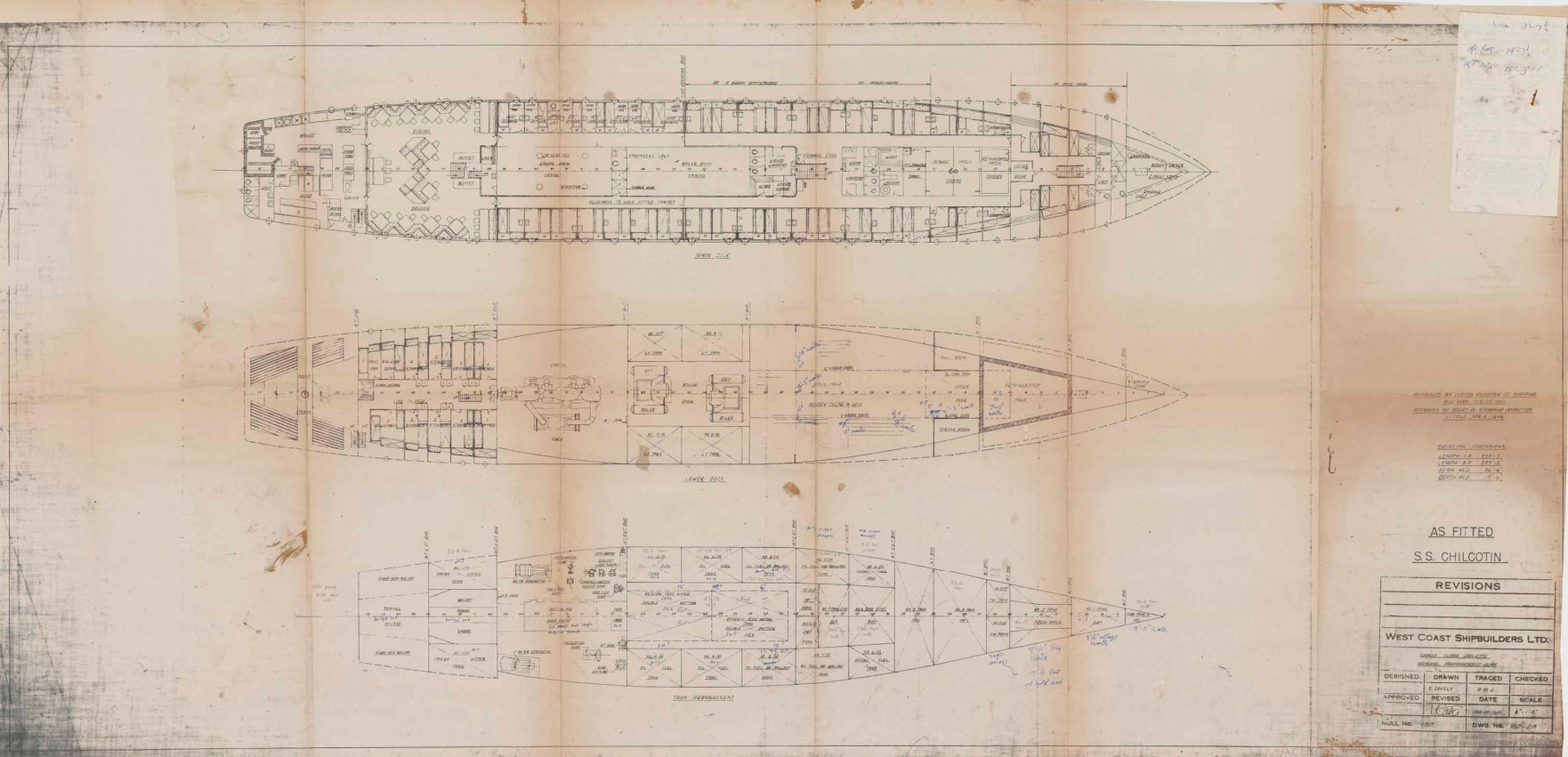
Castle class, deck arrangement plans
The Castle class somewhat were a mix between a Loch class and a modified late Flower class corvette, with extended forecastle and mast behind the bridge, and ended 135 tons heavier and 47 feet longer (14.3 meters) than the original. The Admiralty Works at Haslar which designed many ships in that era, created a model with an improved hull form tested in pool, which took better use of a an increased length for improving both speed and ride large waves with lesser roll and pirch. The more favourable lenght-width ratio made these at least half a knot faster, despite using the same engine as the original Flowers. They still were single-screw, which simplified cost and maintenance, but was a safety issue in case it broke down. A large wave could overturn such ship caught sideways. A lattice mainmast was another big difference in design, adopted from standard designed at the time in 1944. Its strnght was appreciated compared to the simple pole of the Flowers to support large and more powerful radar arrays and other systems.
Hull and general design

Construction still used mainly traditional methods, and still called for welding as much as possible. Scantling was based on the Flower albeit lightened in some areas whereas the the wireless office on board was provided from the same supplied that made it for the Loch class, whereas the radar office and lattice mast were already sent prefabricated and just assembled as single units. With that, they displaced 1,060 long tons (1,077 t) for an overall length of 252 ft (77 m), a beam of 37 ft (11 m) and draught of 10 ft (3 m). In the latter case, it was far less than the Flower class, they had more buoyancy and in general a taller freeboard, being far less “wet” compared to the Flowers, with habitability which was closer to a Loch class.

Powerplant
The Castle class repeated the same powerplant used already on the Flower class Corvettes. At its core, the basic whaler design did not needed two screws and so a single shaft VTE (Vertical, Triple expansion) fed by two admiralty 3-drum boilers were used to produced 2,750 hp. There were variations, since the Improved Flower class had a bit more power. The boilers were of the single-side fire-tube “Scottish” type, Oil-firing. This was enough for a top speed of 16.5 knots (30.6 km/h; 19.0 mph), half a knot improvement, helped also by the new forecastle shape and clipper bow and more refined water lines. The Castle class hwoever were criticized for being barely fast enough to followed surfaced German Type VII at night. They were completely lost by the late variants such as the VIIC/42 capable of 18.6 knots (34.4 km/h; 21.4 mph). In addition they were also difficult to handle at low speed.
Armament
The Castle class were still barebone in armament, with the same single shielded QF 4-inches general purpose gun as prior Flowers, located on a bandstand on the forcastle, to avoid excessive water spray. But this was completed with a Squid anti-submarine mortar installed in a superfiring position behind the banstandand, at the front of the bridge. The hull stretch allowed this important innovation. Hedgehogs/Squid were mandatory on the River class and the Squid was in 1944 the best evolution of the ASW mortar concept. Especially since it was directed by Type 145 and 147B ASDIC. It was jusged way superior to the Hedgehog mortar. This suite was completed by depht charges in standard racks at the stern and four throwers. HMS Hadleigh Castle was the first to mount the Squid/Type 147B ASDIC in September 1943.
QF 4-inch Mk XIX gun
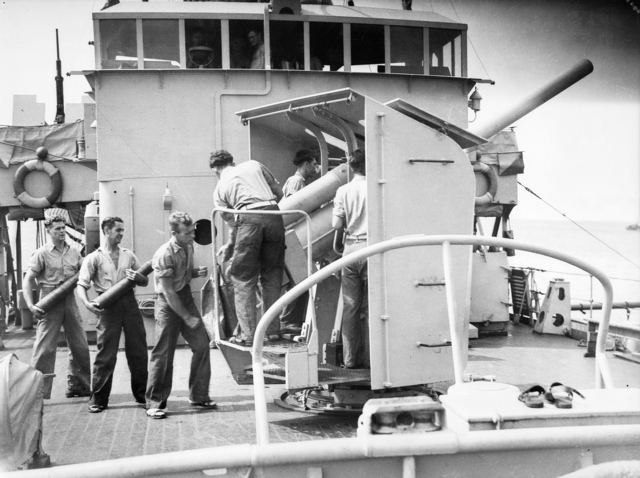
Instead of the older BL 4-inch Mk IX main gun found on the Flower class, the Castles swapped it for the new QF 4-inch Mk XIX gun placed on High-Angle/Low-Angle mounting usabled with much better elevation both against aircraft and low surface targets such as surfaced submarines. This too was a lessons of the engagements made during the war, in which U-Boat surfaced between hunting escorts sometimes at very close range, to close to depress the gun enough. The AA guns were also too high in elevation to do anything while the Type VII’s much lower 8,8 cm and 20 mm FLAK could pepper at will their superstructure (see “greyhound” with tom hanks for illustration).
The Type XIX design started in 1938 but it was only introduced from 1941-42, finding use on the Bathurst class sloops, Castle class Corvettes and River/Loch class corvettes. Another advantage was the capability to fire starshells and illuminate the convoy to spot surfaced U-Boats.
Specs:
Barrel length 160 inches (4.064 m) bore (40 calibres) x 4-inch (101.6 mm)
Shell; Fixed QF HE, Starshell 35 pounds (16 kg) mv 396 mps(1,300 ft/s)
Breech: horizontal sliding-block, elevaiton -10° to +60°, max range 8,870 metres (9,700 yd) at +40°
Squid anti-submarine mortar
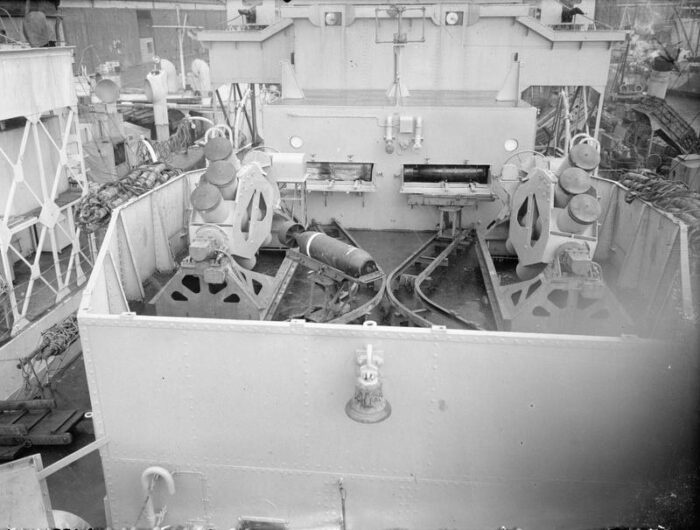
A twin Squid mortar arrangement on the superfiring position of the Loch class. It was a smaller, one mortar system on the Castle’s.
The 305mm/12-in Squid Mk 3 ASWRL was developed in 1942 as a replacement for the imprecise hedgehog, essentially a “spread and pray” type weapon creating a pattern supposed to fall on the enemy submarine’s position. Both both sonars and tacticvs went a long way in hard lessons learned in 1942 and thus a new type of ASW weapon was created, using a coupling with the best SONAR in development at the time with automated aiming, elevation and reload for rapid fire and unparalelled precision. The system created was so good as to be still around in 1977 in the RN and other navies.
The new system was ordered directly from the drawing board in 1942, managed by the Directorate of Miscellaneous Weapons Development and rushed into service in May 1943 on the destroyer leader HMS Ambuscade. The first polished, production was installed on HMS Hadleigh Castle, one of the first Castle class corvettes completed and on the next 70 frigates and corvettes. First successful use was by HMS Loch Killin on 31 July 1944, claiming U-333 and in total it was credited with 17 U-Boats in 50 attacks (2.9 to 1 ratio). Out of 5,174 depth charge attacks by comparion there were only 85.5 confirmed kills so a ratio of 60.5 to 1.
The Hedgehog had a ratio of 5.7 to 1. In 1959, the 195th Squid installation was made.
This was a caracteristic three-barrel 12-inch (305 mm) mortar, mounted in series and off-bore from each other to scatter bombs. A completely differnt system than tiny spigot mortars. The barrels were mounted in a frame allowinf a 90 degrees loadin angle and the projectiles were approaching that of a depht charge at 390 pounds (177 kg) comprising a 207-pound (94 kg) minol charge. The rest was full of propellant.
Squid installations were either at the stern (common postwar) or forward like Hedgehog on the Castle and Loch class vessels. They dropped into the sea with a sink rate of 43.5 ft/s (13.3 m/s) and clockwork time fuze to determine a set detonation depth. This data could be updated right up to any launch, and dive to explode down to max 900 feet (270 m).
They were automatically fired from sonar range recorder and created a pattern in triangle, c40 yards (37 m) wide at 275 yards (251 m) ahead of the ship. The installation being heavy, only post war ships had two sets of mortars. The fuses made sure these exploded some 25 feet (7.6 m) above and below the target. The pressure wave was enough to crush the pressure hull of any U-Boat, or postwar submarine for that matter. Post-war trials showed that by sheer accuracy, this ststem was nine times more effective than conventional depth charges, which led to their disappearance after 1950.
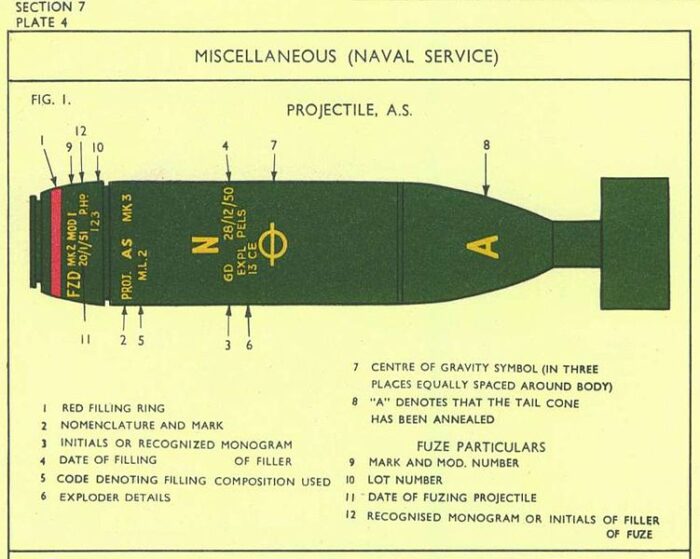
Last known used was in April 1977 by a Type 61 frigate, HMS Salisbury. Some survived on HMS Cavalier (D73), historic ships collection in Chatham, Kent and on HMCS Haida in Hamilton and at the naval museum in Malacca in Malaysia. It was retired in 1982 when the Östergötland-class destroyers were decommissioned.
AA Artillery
The basic defense was ensured by two single 20 mm mounted placed on a large bandstand across the rear amidship deck, behind the funnel. In time, more 20 mm Oerlikon mounts, notably these two were replaced by twin mounts, plus two single, making for six of them.
Depth Charges
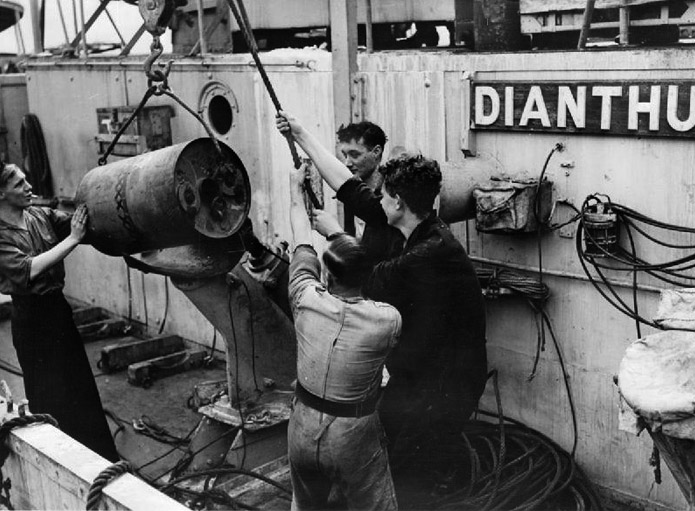
The usual set comprised a single Depth Charge Racks (DCR) at the stern, offset to port with twenty depht charges ready for a full pattern drop. This was completed by four Mark II Depth Charges Throwers (DCT) on the poop deck, facing either side. Each carried five, with railing to the aft superstructure for a total storage of 40 more DCs. Reload was hand made using winches. Standard British type Mark VII (1939) 420 lbs. (191 kg) with a 290 lbs. (132 kg) TNT charge, sink Rate/Terminal Velocity of 9.9 fps (3.0 mps), max setting 300 feet (91 m) and later 500 feet (182 m).
Castle class corvettes were gradually equipped with the Mark X (1944) and Mark X*. The X**, not introduced in service in 1945 and benefiting from a great depth down to 1,500 feet (457 m).
The Mark X weighted 3,050 lbs. (1,383 kg) with an Explosive Charge of 2,000 lbs. (907 kg) TNT and a sink Rate of 6 fps (1.8 mps), 220 feet (67 m) max setting.
Sensors
Type 272 radar
Derived from the Type 271, using the CV35 reflex klystron, remote mount. More
Type 144Q sonar
Introduced in May 1943 for the late Hedgehog and Squid. The Q attachment was an additional Asdic set with separate transmitting and receiving equipment. The Q oscillator was mounted beneath the main oscillator, trained with it, projecting a fan shaped beam narrower in the horizontal but wide vertically to receive echoes at any angle up to 45 degrees below horizontal. This arrangement allowed angles up to 70 degrees from the bow. Range was selectable between 1000 and 2500 yards.
More and this video
Type 147B sonar
The 147B was ideally paired with the 144Q. This was a depth finding set with a sword shaped oscillator operating at 50 Kcs. and able to measure depths up to 1200 feet. It was mounted ahead of the main 144Q set, stored in a lifting tube within the hull when not in use, with angles whe deployed 65°H, 45°V capable of accurately track a target within 20 feet and integrated with Squid, forming together the most effective A/S weapons system of World War II.

HMS Hadleigh Castle (K335) from Conways.
⚙ specifications |
|
| Displacement | 1,060 long tons (1,077 t) |
| Dimensions | 252 x 37 x 10 ft (77 x 11 x 3 m) |
| Propulsion | 1 shaft, 4-cyl. VTE, 2× water-tube boilers 2,750 hp (2.05 MW) |
| Speed | 16.5 knots (30.6 km/h; 19.0 mph) |
| Range | 9,500 nmi (17,600 km) at 10 kn (19 km/h; 12 mph) |
| Armament | 1× 4-in QF Mk.XIX HA gun, Squid ASWM, DCR (15), 2-6× 20 mm AA |
| Sensors | Type 272 radar, Type 144Q sonar, Type 147B sonar |
| Crew | 112 |
The Canadian Castle
Unlile for the Flower class, especially the modified ones in 1942, nearly all Canadian built, production in Canada of 37 Castle class, that late into the war, was cancelled altogether. Instead,; the RCN obtained twelve British built Castle class corvettes, thus they were rigourously identical and no extra detail will be given on potential specifics, but if found. Here is an example career and brief fates of these twelve ships.
 HMCS Arnprior (K494) (ex-HMS Rising Castle)
HMCS Arnprior (K494) (ex-HMS Rising Castle)
She was ordered on 23 January 1943, laid down at Harland and Wolff, Belfast (Yard number 1240) on 21 June 1943, launched on 8 February 1944 and completed on 26 June 1944. Transferred to the Royal Canadian Navy as HMCS Arnprior on 8 June 1944, before completion, in exchange for Algerine-class minesweepers. After training at Tobermory she was assigned to the Mid-Ocean Escort Force, escort group C-1 in Derry. She joined convoy ONM-249 on 19 August 1944 and took part in the Battle of the Atlantic until June 1945, refitted at St. John’s for two months and based at Halifax until decommissioned on 14 March 1946, sold to Uruguay as the TS Montevideo until 1975.
 HMCS Bowmanville (K493) (ex-HMS Nunney Castle)
HMCS Bowmanville (K493) (ex-HMS Nunney Castle)
She was built at William Pickersgill & Sons Ltd, Sunderland, laid down on 12 August 1943, launched on 26 January 1944, transferred to the Royal Canadian Navy, Commissioned on 28 September 1944. Mid-Ocean Escort Force escort group C-4 until June 1945, based in Halifax until paid off 15 January 1946. Sold to ROCA as cargo ship, taken over by the PLAN after the end of the Civil War, rearmed with Soviet guns, served as Guangzhou until 1976.
 HMCS Copper Cliff (K495) (ex-HMS Hever Castle)
HMCS Copper Cliff (K495) (ex-HMS Hever Castle)
Ordered 23 January 1943 at Blyth Shipbuilding and Dry Dock Company, she was laid down on 29 June 1943, launched on 24 February 1944 and transferred to the Royal Canadian Navy as Copper Cliff (Ontario), Commissioned on 25 February 1944. Assigned to the Mid-Ocean Escort Force (escort group C-6) as convoy escort in August 1944. Tested the Type 277 radar. In October serrved with group C-7 unyil June 1945, Halifax, and Esquimalt unyil 21 November, paid off, placed in reserve, sold in 1946 as mercantile Ta Lung, converted to cargo ship 1,305 tons GRT. Renamed Wan Lee in 1947, to PRC 1949, listed until 1968.
 HMCS Hespeler (K489) (ex-HMS Guildford Castle
HMCS Hespeler (K489) (ex-HMS Guildford Castle
Ordered 19 January 1943 at Henry Robb Ltd, Leith, laid down 25 May 1943, launched 13 November 1943, transferred to the RCN as Hespeler, commissioned on 28 February 1944. Trained at Tobermory. Mid-Ocean Escort Force, escort group C-5 and took part in HX 300. 9 September 1944 south of Hebrides, with River class HMCS Dunver attacked bt Squid and sank U-484, previously spotted by a Short Sunderland from 423 Sqn RCAF. Refit Halifax and Liverpool, based in Esquimalt until PO reserve 15 November. Sold in 1946 as transport ship SS Chilcotin 1837t cargo, Capri, Vestar, lost 1966 in Sardinia (fire).
 HMCS Humberstone (K497) (ex-HMS Norham Castle)
HMCS Humberstone (K497) (ex-HMS Norham Castle)
Ordered 19 December 1942 at A. & J. Inglis Ltd, Glasgow, laid down on 30 August 1943, launched on 12 April 1944, transferred as Humberstone; commissioned 6 September 1944. Mid-Ocean Escort Force, escort group C-8 until May 1945, sent to Esquimalt, PO 17 November 1945. 1946, sold for mercantile service as 1,304 tons GRT cargo Taiwei, Shanghai, sold 1947 Chang Chen, 1949, Tai Shan, King Kang, 1950 sold as Flying Dragon, San Blas, South Ocean (Korean flag) BU Hong Kong September 1959.
 HMCS Huntsville (K499) (ex-HMS Woolvesey Castle)
HMCS Huntsville (K499) (ex-HMS Woolvesey Castle)
Ordered 23 January 1943 at Ailsa Shipbuilding Co. Ltd. in Troon she was laid down on 1 June 1943; launched on 24 February 1944, transferred to RCN as Huntsville, commissioned on 6 June 1944. Trained in Stornoway and integrated the Mid-Ocean Escort Force escort group C-5. In November she missed her group and instead acted as local escort, between St. John’s and New York City. She returtned to C5 in December and continued and until May 1945. Refitted in Halifax, completed in August, in reserve, paid off 15 February 1946, sold as mercantile 1,529 tons GRT as SS Wellington Kent.1951, Belle Isle II, badly damaged in collision 19 August 1960 off Trois-Rivières, Quebec, BU 1965–66.
 HMCS Kincardine (K490) (ex-HMS Tamworth Castle)
HMCS Kincardine (K490) (ex-HMS Tamworth Castle)
Ordered 19 January 1943 at Henry Robb Ltd, Leith, laid down on 25 August 1943, launched 26 January 1944, transferred to the RCN, renamed Kincardine, commissioned 19 June 1944. Trained at Tobermory, Mid-Ocean Escort Force C-2 August 1944. Repaired at Smiths Dock, deployed as a local escort until 2 October. Last mission June 1945, TS in July attached to HMCS Cornwallis. Refitted at Liverpool, reserve at Halifax, PO 27 February 1946, sold to French Gvt September 1946 and resold to Morocco in 1947 as Saada, GRT 1,516 tons as fruit cargo based in Casablanca, BU La Spezia 15 September 1953.
 HMCS Leaside (K492) (ex-HMS Walmer Castle)
HMCS Leaside (K492) (ex-HMS Walmer Castle)
Ordered 19 January 1943 at Smiths Dock Company, South Bank, laid down 23 September 1943, launched 10 March 1944, transferred RCN as Leaside, commissioned 21 August 1944. Later SS Coquitlam II, changed hands, BU 1979.
 HMCS Orangeville (K491) (ex-HMS Hedingham Castle)
HMCS Orangeville (K491) (ex-HMS Hedingham Castle)
Laid down 2 November 1943 at John Brown, Launched 30 October 1944, reallocated to the Royal Canadian Navy before launching, renamed HMCS Orangeville, decom. August 1945. Sold to Republic of China as cargo ship, but taken over by the ROC Navy on 29 June 1950 and rearmed with US guns, entering ROCN service as De An (德安).
 HMCS Petrolia (K498) (ex-HMS Sherborne Castle)
HMCS Petrolia (K498) (ex-HMS Sherborne Castle)
Petrolia was born as Sherborne Castle (Dorset) by Harland and Wolff, Belfast, laid down on 21 June 1943, launched on 24 February 1944, transferred, Commissioned on 29 June 1944, trained at Tobermory, versed to Mid-Ocean Escort Force C-3 July 1944. Last crossing in June 1945. August 1945 refit at Charlottetown, Prince Edward Island, reserve at Halifax in October. Sold for mercantile 8 March 1946, Castle Sg Co SA as “Maid of Athens”, converted to cargo ship 1,541 tons GRT, then Bombay, Bharat Line Ltd. as Bharat Laxmi. In service until May 1965, BU.
 HMCS St. Thomas (K488) (ex-HMS Sandgate Castle
HMCS St. Thomas (K488) (ex-HMS Sandgate Castle
Ordered 19 January 1943, built at Smiths Dock Company, Southbank-on-Tees, Laid down on 23 June 1943, Launched on 28 December 1943, transferred to RCN as St. Thomas (Ontario), recommissioned 4 May 1944 under Commander Leslie Perman Denny, RCNR. Joined the Mid-Ocean Escort Force escort group C-3, escorted 13 convoys in the North Atlantic, credited with the sinking of U-877, 27 December 1944. Happened north-west of the Azores 1,000 kilometres (620 mi) off the coast of Newfoundland. She twice detected and used her Squid but apparently missed and begun to withdraw, when the damaged U-boat surfaced 4 km (2.5 mi) away. Instead of attacking she close in and rescued the whole crew as POW and ensured U-877 sank. She had a refit at Halifax in April 1945, sailed to Esquimalt in British Columbia in July until paid off 22 November 1945. Later sold to mercantile as SS Camosun III, Chilcotin (1958), Yukon Star (1958), discarded 1970, BU 1974.
 HMCS Tillsonburg (K496) (ex-HMS Pembroke Castle)
HMCS Tillsonburg (K496) (ex-HMS Pembroke Castle)
Pembroke Castle (Wales) was laid down on 3 June 1943 by Ferguson Brothers Ltd., Port Glasgow, Launched 12 February 1944, transferred and recommissioned on 29 June 1944 to the Royal Canadian Navy and renamed Tillsonburg (southern Ontario) pennant K496. Trained at Stornoway, joined the Mid-Ocean Escort Force group C-3. Until the end of the war, final crossing mid-June 1945. Based at St. John’s, Sydney and Halifax for brief periods, paid off Halifax 15 February 1946. Sold to Republic of China as cargo ship, but taken over by ROCN on 29 June 1950 and rearmed with US guns, entering ROCN service as Kao An (高安). Taken over by Nationalist Chinese government 1 June 1950, renamed twice, Discarded 1963.
Career of the RN Castle class
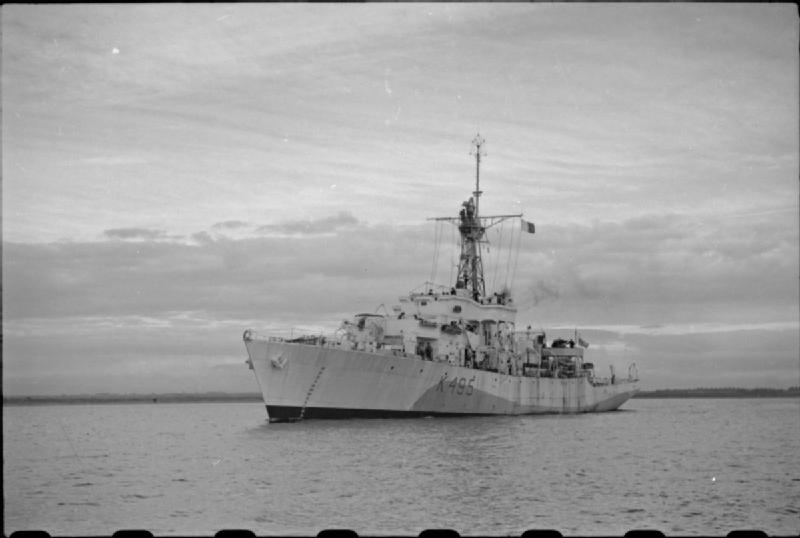
HMS Coppercliff
 Hadleigh Castle (K355)
Hadleigh Castle (K355)
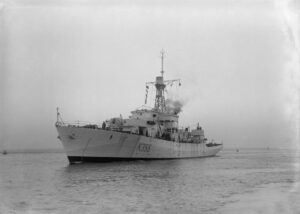 Hadleigh Castle was ordered to Smiths Dock Co. on 9 Dec 1942, laid down on 4 Apr 1943, launched on 21 Jun 1943 and completed on 18 Sep 1943. She trained at Obermory until November-December 1943. Local escorts Jan-May 1944. During her service she escorted the Combined convoy OS 78/KMS 52 in May 1944, Convoy OS 78 in June 1944 and Convoy KMS 52, Convoy SL 164 in July 1944, local escort and exercises until 16 Apr 1945. Full logs Reserve 1948, BU 1959.
Hadleigh Castle was ordered to Smiths Dock Co. on 9 Dec 1942, laid down on 4 Apr 1943, launched on 21 Jun 1943 and completed on 18 Sep 1943. She trained at Obermory until November-December 1943. Local escorts Jan-May 1944. During her service she escorted the Combined convoy OS 78/KMS 52 in May 1944, Convoy OS 78 in June 1944 and Convoy KMS 52, Convoy SL 164 in July 1944, local escort and exercises until 16 Apr 1945. Full logs Reserve 1948, BU 1959.
 Kenilworth Castle (K420)
Kenilworth Castle (K420)
 HMS Kenilworth Castle was ordered at Smiths Dock Co. on 9 Dec 1942, laid down on 7 May 1943, launched on 17 August 1943 and completed on 22 Nov 1943. In her convoy escort missions she took part in the sinking of U-744 on 6 March 1944 by HMS Icarus, HMCS St. Catharines, HMCS Fennel, HMCS Chilliwack, HMCS Chaudiere, HMCS Gatineau and Kenilworth Castle and U-1200 south of Ireland by HMS Pevensey Castle, HMS Launceston Castle, HMS Portchester Castle and Kenilworth Castle on 11 November 1944 as part of the 30th Escort Group (Commander Denys Rayner). Reserve in 1948, scrapped at Llanelli in June 1956. Logs On Uboat.net
HMS Kenilworth Castle was ordered at Smiths Dock Co. on 9 Dec 1942, laid down on 7 May 1943, launched on 17 August 1943 and completed on 22 Nov 1943. In her convoy escort missions she took part in the sinking of U-744 on 6 March 1944 by HMS Icarus, HMCS St. Catharines, HMCS Fennel, HMCS Chilliwack, HMCS Chaudiere, HMCS Gatineau and Kenilworth Castle and U-1200 south of Ireland by HMS Pevensey Castle, HMS Launceston Castle, HMS Portchester Castle and Kenilworth Castle on 11 November 1944 as part of the 30th Escort Group (Commander Denys Rayner). Reserve in 1948, scrapped at Llanelli in June 1956. Logs On Uboat.net
 Allington Castle (K689)
Allington Castle (K689)
Allington Castle was ordered at Fleming & Ferguson on 9 Dec 1942, laid down on 22 Jul 1943, launched on 29 Feb 1944 and completed on 19 June 1944. Convoy escort until the end of the Second World War, May 1945. Placed in reserve on 25 May. Reactivated in November, Fishery Protection Flotilla, Fleetwood. In 1947 back to reserve, sold BU at Sunderland on 20 December 1958. Full logs
 Bamborough Castle (K412)
Bamborough Castle (K412)
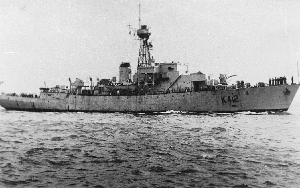 Bamborough Castle was ordered to John Lewis & Co. Ltd on 9 Dec 1942, laid down 1 Jul 1943, launched 11 Jan 1944, completed 30 May 1944. Convoy escort, sinking U-387 in the Barents Sea with depth charges on 9 December 1944.Placed in reserve 25 May 1945, reactivated January 1946 Fishery Protection Flotilla in Plymouth, reserve in 1947, sold for scrap in 1959, Llanelli. Full logs
Bamborough Castle was ordered to John Lewis & Co. Ltd on 9 Dec 1942, laid down 1 Jul 1943, launched 11 Jan 1944, completed 30 May 1944. Convoy escort, sinking U-387 in the Barents Sea with depth charges on 9 December 1944.Placed in reserve 25 May 1945, reactivated January 1946 Fishery Protection Flotilla in Plymouth, reserve in 1947, sold for scrap in 1959, Llanelli. Full logs
 Caistor Castle (K690)
Caistor Castle (K690)
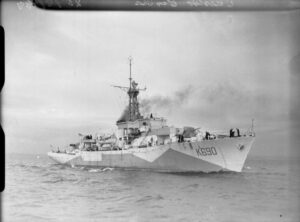 She was ordered to John Caistor Castle (of Harry potter fame) was ordered to Lewis & Co. Ltd on 9 Dec 1942, laid down on 26 Aug 1943, launched on 22 May 1944, completed 29 September 1944. She was a convoy escort until May 1945. Placed in reserve at Devonport from 1947 to 1948, she still represented the Reserve Fleet at the 1953 Coronation Review and was par tof the Second Training Squadron at Portland from February 1953 until 1955. Back in reserve at Devonport she was sold to Arnott Young in 1956, Dalmuir. Full logs
She was ordered to John Caistor Castle (of Harry potter fame) was ordered to Lewis & Co. Ltd on 9 Dec 1942, laid down on 26 Aug 1943, launched on 22 May 1944, completed 29 September 1944. She was a convoy escort until May 1945. Placed in reserve at Devonport from 1947 to 1948, she still represented the Reserve Fleet at the 1953 Coronation Review and was par tof the Second Training Squadron at Portland from February 1953 until 1955. Back in reserve at Devonport she was sold to Arnott Young in 1956, Dalmuir. Full logs
 Denbigh Castle (K696)
Denbigh Castle (K696)
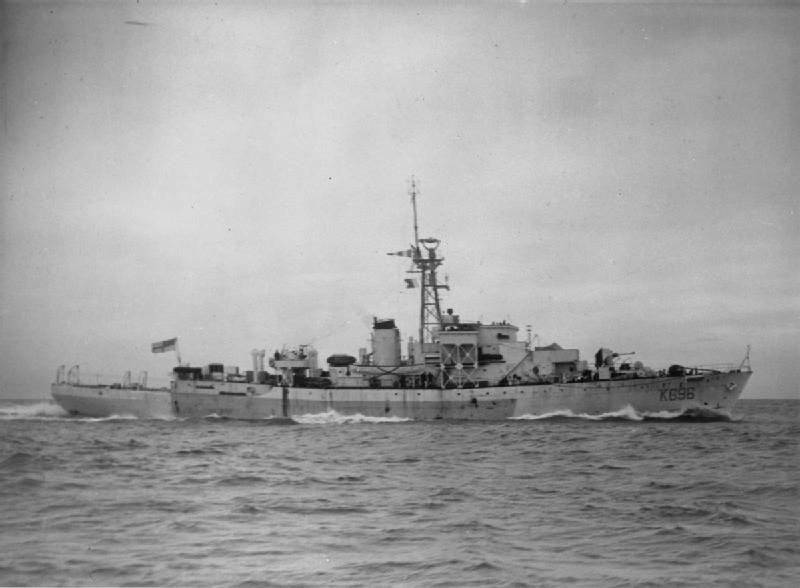
HMS Denbigh castle (IWM)
She was ordered to John Lewis & Co. Ltd on 9 Dec 1942, laid down on 30 Sep 1943, launched on 5 Aug 1944, completed on 30 December 1944. She trained at Tobermory, Mull, Scotland on 12 January 1945 at the ASW Training School HMS Western Isles. When done, she sailed to Scapa Flow on 29 January to join the 7th Escort Group under Lt. Cdr Graham Butcher, escorting Convoy JW 64 to Murmansk in February 1945. On the 7th, Denbigh Castle claimed a German torpedo bomber but a week later, she was torpedoed by U-992 when entering the Kola Inlet on 13 February. Her radar just picked up the U-Boat at 2,500 yards (2,300 m), but was not on battle stations due to confused radar returns and darkness. She was hit in the bow and the crew believed this was a mine (11 ratings). She lost her main gun and squd in the detonation. The hole mushed remnant sagged downwards, but she still was in no danger of sinking. HMS Serapis transferred her medical officer and she was assisted by the corvette Bluebell to receive casualties. She was mostly evacuated, towing by Bluebell at 02:05, at 2 knots (3.7 km/h; 2.3 mph), then taken in tow by salvage ship Buresvestnik at 04:30 and installed a 100-tonne (98-long-ton) salvage pump, still she continued to slowly sinking by the bow and kept only a few officers aboard. Buresvestnik’s captain took over the tow at 06:15 to beached her at 07:30 at Bolshaya Volokovaya Bay near Vaenga, evacuated at 09:05 and she capsized, slid into deeper water. The cruiser Bellona destroyed her radar office. Declared constructive total loss, 13 Feb 1945. Full logs
 Farnham Castle (K413)
Farnham Castle (K413)
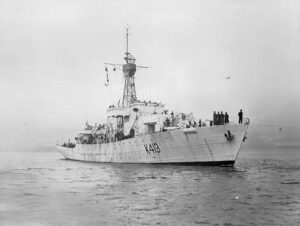 Farnham Castle (K413) was ordered to John Crown & Sons Ltd 9 Dec 1942, laid down on 25 Jun 1943, launched on 25 Apr 1944 and completed on 31 Jan 1945. She was placed in reserve in 1947, Scrapped, 31 Oct 1960. Full logs
Farnham Castle (K413) was ordered to John Crown & Sons Ltd 9 Dec 1942, laid down on 25 Jun 1943, launched on 25 Apr 1944 and completed on 31 Jan 1945. She was placed in reserve in 1947, Scrapped, 31 Oct 1960. Full logs
 Hedingham Castle (K529)
Hedingham Castle (K529)
 She was ordered to John Crown & Sons Ltd on 9 Dec 1942, laid down on 2 Nov 1943, launched on 30 Oct 1944 and completed on 12 May 1945, decom. Aug 1945, reserve, scrapped, Apr 1958. In 1953 she took part in the Fleet Review for the Coronation of Queen Elizabeth II. She plays in the film Seagulls Over Sorrento (Crest of the Wave) by Roy Boulting on 1954. Full logs
She was ordered to John Crown & Sons Ltd on 9 Dec 1942, laid down on 2 Nov 1943, launched on 30 Oct 1944 and completed on 12 May 1945, decom. Aug 1945, reserve, scrapped, Apr 1958. In 1953 she took part in the Fleet Review for the Coronation of Queen Elizabeth II. She plays in the film Seagulls Over Sorrento (Crest of the Wave) by Roy Boulting on 1954. Full logs
 Lancaster Castle (K691)
Lancaster Castle (K691)
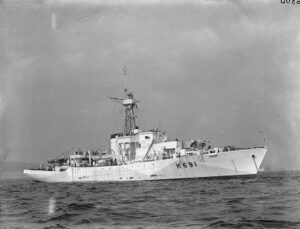 Lancaster Castle (K691) was ordered to Fleming & Ferguson on 9 Dec 1942, laid down on 10 Sep 1943, launched on 14 Apr 1944, completed on 15 Sep 1944. By November 1944, she joined 31st Escort Group with Berkeley Castle, Carisbrooke Castle, Dumbarton Castle, and Hadleigh Castle. In December they were deployed to the Atlantic North West Approaches until March 1945, detached for Russian convoy defence with Home Fleet units. On 20 March 1945 when escorting JW 65 they were attacked by a worlfpack of six U-Boats (HMS Lapwing, Horace Bushnel, Thomas Donaldson lost). On 1 April 1945 she worked with convoy RA 65 at Scapa Flow and the 31st Escort Group, British coastal waters. On 8 May, she was sent to support of occupation forces and collect surrendered U-Boats. In 1946, she was paid-off in reserve at Portsmouth. Refitted at Cardiff, transferred to the Reserve Fleet Division (Harwich) in 1949 and after 1953, to Hartlepool, laid-up and in 1957 sold for BU to Gateshead 20 Jun 1959. Full logs
Lancaster Castle (K691) was ordered to Fleming & Ferguson on 9 Dec 1942, laid down on 10 Sep 1943, launched on 14 Apr 1944, completed on 15 Sep 1944. By November 1944, she joined 31st Escort Group with Berkeley Castle, Carisbrooke Castle, Dumbarton Castle, and Hadleigh Castle. In December they were deployed to the Atlantic North West Approaches until March 1945, detached for Russian convoy defence with Home Fleet units. On 20 March 1945 when escorting JW 65 they were attacked by a worlfpack of six U-Boats (HMS Lapwing, Horace Bushnel, Thomas Donaldson lost). On 1 April 1945 she worked with convoy RA 65 at Scapa Flow and the 31st Escort Group, British coastal waters. On 8 May, she was sent to support of occupation forces and collect surrendered U-Boats. In 1946, she was paid-off in reserve at Portsmouth. Refitted at Cardiff, transferred to the Reserve Fleet Division (Harwich) in 1949 and after 1953, to Hartlepool, laid-up and in 1957 sold for BU to Gateshead 20 Jun 1959. Full logs
 Maiden Castle (K443)
Maiden Castle (K443)
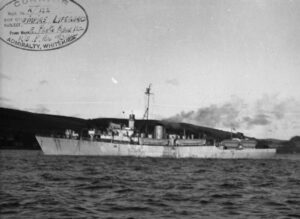 Ordered to Fleming & Ferguson on 9 Dec 1942 and laid down 1943, launched 8 Jun 1944 she was completed on November 1944. She Became the convoy rescue ship Empire Lifeguard before completion. Despite her role to pick up survivors of convoys, she still acted as convoy escort until the end of the Second World War in May 1945, placed in reserve on 25 May, reactivated in November, assigned to the Fishery Protection Flotilla in Fleetwood, reserve 1947, sold BU at Sunderland 22 December 1955. Transported the Shore Party at Murmansk to the Clyde, was in to Kiel to take another Naval party to Devonport. Postwar Home fleet, Mediterranean, Army Transport, including Jewish refugees to Palestine. 23 July 1947 sunk in Haifa harbour near Haganah with a bomb while discharging 300 Jewish immigrants, 66 immigrants killed, 40 wounded. Later raised and scrapped 22 June 1955.
Ordered to Fleming & Ferguson on 9 Dec 1942 and laid down 1943, launched 8 Jun 1944 she was completed on November 1944. She Became the convoy rescue ship Empire Lifeguard before completion. Despite her role to pick up survivors of convoys, she still acted as convoy escort until the end of the Second World War in May 1945, placed in reserve on 25 May, reactivated in November, assigned to the Fishery Protection Flotilla in Fleetwood, reserve 1947, sold BU at Sunderland 22 December 1955. Transported the Shore Party at Murmansk to the Clyde, was in to Kiel to take another Naval party to Devonport. Postwar Home fleet, Mediterranean, Army Transport, including Jewish refugees to Palestine. 23 July 1947 sunk in Haifa harbour near Haganah with a bomb while discharging 300 Jewish immigrants, 66 immigrants killed, 40 wounded. Later raised and scrapped 22 June 1955.
 Norham Castle K447
Norham Castle K447
Northam Castle was ordered as Totnes Castle to A. & J. Inglis on 9 Dec 1942, laid down on 30 Sep 1943 and launched on 12 Apr 1944, completed on 6 Sep 1944, transferred to Canada as HMCS Humberstone 1944. She trained at Tobermory and joined the Mid-Ocean Escort Force, escort group C, paid off 17 November 1945, sold for mercantile service, converted as cargo ship Taiwei.
 Oakham Castle (K530)
Oakham Castle (K530)
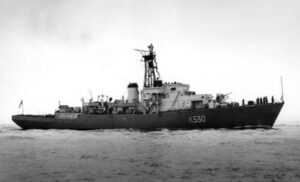 She was ordered at A. & J. Inglis on 9 Dec 1942, laid down on 30 Sep 1943, launched 20 Jul 1944, completed 10 Dec 1944. After escorts missiones until May 1945, she was placed in reserve, reactivated in 1948, 2nd Training Squadron at Portland Harbour until December 1950, reserve at Devonport. Refitted in 1953, laid up in a preserved condition at South Shields, transferred to the Met Office in 1957, converted as Weather ship by James Lamont & Co. at Greenock. On 16 May 1958 she became Weather Reporter by Lord Hurcomb and was scrapped in 1977.
She was ordered at A. & J. Inglis on 9 Dec 1942, laid down on 30 Sep 1943, launched 20 Jul 1944, completed 10 Dec 1944. After escorts missiones until May 1945, she was placed in reserve, reactivated in 1948, 2nd Training Squadron at Portland Harbour until December 1950, reserve at Devonport. Refitted in 1953, laid up in a preserved condition at South Shields, transferred to the Met Office in 1957, converted as Weather ship by James Lamont & Co. at Greenock. On 16 May 1958 she became Weather Reporter by Lord Hurcomb and was scrapped in 1977.
 Rayleigh Castle (K695)
Rayleigh Castle (K695)
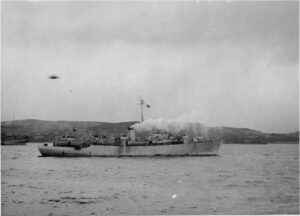 Rayleight was ordered to Ferguson Shipbuilders on 9 Dec 1942, she was laid down in 1943, launched on 12 Jun 1944 and completed on Oct 1944 as convoy rescue ship Empire Rest under the ownership of the Ministry of War Transport and managed by the Ellerman City Line. She covered 11 convoys between November 1944 and June 1945 but made no rescues. In November 1945 she was in Kiel to repatriate Royal Navy personnel and was used as transport in the Mediterranean by 1947, notably with illegal Jewish immigrants from Haifa to internment camps on Cyprus. In July 1948 she was laid up at Falmouth, sold October 1949 to Lloyds Albert Yard & Motor Boat Packet Services Ltd in October 1951 but resold to Thos. W. Ward of Briton Ferry, to be scrapped on 6 June 1952.
Rayleight was ordered to Ferguson Shipbuilders on 9 Dec 1942, she was laid down in 1943, launched on 12 Jun 1944 and completed on Oct 1944 as convoy rescue ship Empire Rest under the ownership of the Ministry of War Transport and managed by the Ellerman City Line. She covered 11 convoys between November 1944 and June 1945 but made no rescues. In November 1945 she was in Kiel to repatriate Royal Navy personnel and was used as transport in the Mediterranean by 1947, notably with illegal Jewish immigrants from Haifa to internment camps on Cyprus. In July 1948 she was laid up at Falmouth, sold October 1949 to Lloyds Albert Yard & Motor Boat Packet Services Ltd in October 1951 but resold to Thos. W. Ward of Briton Ferry, to be scrapped on 6 June 1952.
 Alnwick Castle (K405)
Alnwick Castle (K405)
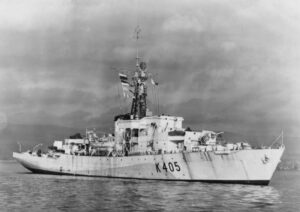 She was ordered to George Brown & Co. on 19 Jan 1943, launches 23 May 1943, completed 11 Oct 1944. She served as a convoy escort until May 1945. On 17 February under Lt. Cdr. H.A. Stonehouse co-claimed with HMS Lark U-425 near Murmansk. She was reserve on 25 May, sold for scrap in 1958 at Gateshead.
She was ordered to George Brown & Co. on 19 Jan 1943, launches 23 May 1943, completed 11 Oct 1944. She served as a convoy escort until May 1945. On 17 February under Lt. Cdr. H.A. Stonehouse co-claimed with HMS Lark U-425 near Murmansk. She was reserve on 25 May, sold for scrap in 1958 at Gateshead.
 Barnard Castle (K594)
Barnard Castle (K594)
Barnard Castle was ordered to George Brown & Co. in 1943, launched 3 Oct 1944, completed on 17 April 1945 as the convoy rescue ship Empire Shelter. Work was then cancelled, so to be completed as convoy rescue ship, under the Ministry of War Transport for the Ellerman City Line, and present on six convoys over a month, but making made no rescues. On 22 May 1945 she was in reserve and became an accommodation ship 3rd Submarine Flotilla, Holy Loch. She next became a troopship and in 1955 she was laid up in the River Fal, sold for scrap that year at Burght, Belgium, 29 July 1955.
 Flint Castle (K383)
Flint Castle (K383)
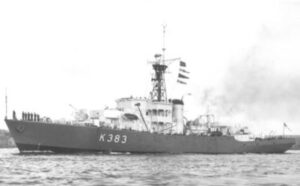 Flint Castle was ordered to Henry Robb at Leith, laid dowb on 20 Apr 1943, launched 1 Sep 1943, completed on 31 Dec 1943. She was damaged by an accidental explosion alongside the Barrage Vessel BV 42 on 22 December 1943 (1 killed) which saw BV 42 sinking. She trained at Tobermory, Mull on 12 January 1944 and startred training at the ASW training School HMS Western Isles. She ran aground on 18 January. She was repaired at Belfast until 9 February. She joined 39th Escort Group first convoy on mid-March and then at Liverpool, Escort Group B2 for convoys to and from Gibraltar. In September 1944, she joined Escort Group B3, protecting convoys between St. John’s and Labrador to UK. Refitted in Cardiff January–March 1945.
Flint Castle was ordered to Henry Robb at Leith, laid dowb on 20 Apr 1943, launched 1 Sep 1943, completed on 31 Dec 1943. She was damaged by an accidental explosion alongside the Barrage Vessel BV 42 on 22 December 1943 (1 killed) which saw BV 42 sinking. She trained at Tobermory, Mull on 12 January 1944 and startred training at the ASW training School HMS Western Isles. She ran aground on 18 January. She was repaired at Belfast until 9 February. She joined 39th Escort Group first convoy on mid-March and then at Liverpool, Escort Group B2 for convoys to and from Gibraltar. In September 1944, she joined Escort Group B3, protecting convoys between St. John’s and Labrador to UK. Refitted in Cardiff January–March 1945.
Assigned to Rosyth Command in June as ASW TS visited Norway and Germany, transferred to the Rosyth Escort Force by June 1946, then in the Basic Anti-Submarine Training Flotilla in September, transferred to Portland, and becoming the 2nd Training Squadron in January 1952. On 15 June 1953 she was at Spithead for the Coronation of Queen Elizabeth II. She portrayed a German vessels in the 1955 film The Cockleshell Heroes. She was decommissioned in March 1956 at Devonport, BU from 10 July 1958 at Faslane.
 Knaresborough Castle (K389)
Knaresborough Castle (K389)
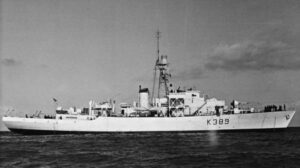
Knaresborough Castle was ordered to Blyth Dry Dock and laid down on 22 Apr 1943, launched 1 Sep 1943, completed 5 April 1944. She served as a convoy escort without notable event and in 1953 took part in the Fleet Review for the Coronation of Queen Elizabeth II. She was scrapped at Glasgow in March 1956.
 Launceston Castle (K397)
Launceston Castle (K397)
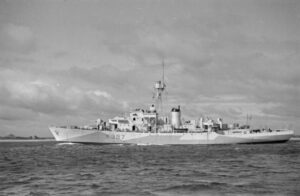 She was ordered to Blyth Dry Dock and laid down on 27 May 1943, launched on 27 Nov 1943, and completed on 20 June 1944. She served as a convoy escort with the 30th Escort Group under Denys Rayner RNVR (Flag HMS Pevensey Castle=. She sank U-1200 south of Ireland on 11 November 1944 with Pevensey Castle, Kenilworth Castle and Portchester Castle. Discarded 1947, reserve, in 1953 she took part in the Fleet Review to celebrate the Coronation of Queen Elizabeth II. Crapped 1959.
She was ordered to Blyth Dry Dock and laid down on 27 May 1943, launched on 27 Nov 1943, and completed on 20 June 1944. She served as a convoy escort with the 30th Escort Group under Denys Rayner RNVR (Flag HMS Pevensey Castle=. She sank U-1200 south of Ireland on 11 November 1944 with Pevensey Castle, Kenilworth Castle and Portchester Castle. Discarded 1947, reserve, in 1953 she took part in the Fleet Review to celebrate the Coronation of Queen Elizabeth II. Crapped 1959.
 York Castle (SS Empire Comfort)
York Castle (SS Empire Comfort)
Laid down at Ferguson Brothers, Port Glasgow in 1944, construction suspended and resumed as rescue corvettes (unarmed) under the ministry of transports launched on 20 Sep 1944 and completed in Feb 1945 as convoy rescue ship SS Empire Comfort. She escorted OS 113, MKS 85G (Med), OS 116, MKS 88G (Med), OS 121, MKS 93G (Med). In 1948 she was Mediterranean troop transport, Middle East Command between Port Said, and Famagusta in Cyprus and Port Said-Tobruk from July 1948 to February 1949. In 1954 she was laid up at Falmouth and in June 1955 with Empire Lifeguard and Empire Peacemaker offered for sale, to Belgian buyers in Antwerp, not converted, scrapped December 1955 at Ghent.
 Leeds Castle (K384)
Leeds Castle (K384)
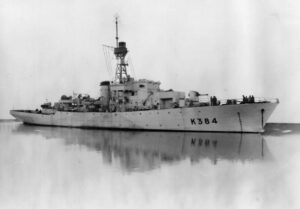 She was ordered to William Pickersgill & Sons on 23 Jan 1943, laid down 22 Apr 1943, launched 12 Oct 1943, completed 15 Feb 1944. She served in B3 Escort Group until May-June 1945. Reserve 1947. Reactivated, ASW Training Squadron at Portland until paid off at Chatham in November 1956, 12.5 years service with F384 pennant. In 1953 she was at the Spithead Fleet Review for the Coronation of Queen Elizabeth II, scrapped in 1958. In 1955 she took part in the film “The Cockleshell Heroes” as HMS Flint Castle.
She was ordered to William Pickersgill & Sons on 23 Jan 1943, laid down 22 Apr 1943, launched 12 Oct 1943, completed 15 Feb 1944. She served in B3 Escort Group until May-June 1945. Reserve 1947. Reactivated, ASW Training Squadron at Portland until paid off at Chatham in November 1956, 12.5 years service with F384 pennant. In 1953 she was at the Spithead Fleet Review for the Coronation of Queen Elizabeth II, scrapped in 1958. In 1955 she took part in the film “The Cockleshell Heroes” as HMS Flint Castle.
 Morpeth Castle (K693)
Morpeth Castle (K693)
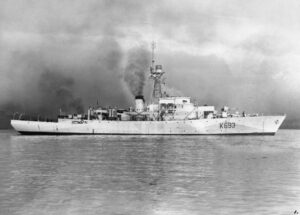 She was ordered to William Pickersgill & Sons 23 Jan 1943, was laid down on 23 Jun 1943, launched on 26 Nov 1943, and completed on 13 Jul 1944, discarded 1946, in reserve, and BU 9 Aug 1960. She had as commanders Lt.Cdr. Eric Robert Pate until Jun 1945 and Lt.Cdr. Leslie Frederick Lewis Hill until Mar 1946. She was in ASW exercises with various submarines such as HMS Vitality, Vampire, Tireless, Surf, Astute, Full records on Uboat.net
She was ordered to William Pickersgill & Sons 23 Jan 1943, was laid down on 23 Jun 1943, launched on 26 Nov 1943, and completed on 13 Jul 1944, discarded 1946, in reserve, and BU 9 Aug 1960. She had as commanders Lt.Cdr. Eric Robert Pate until Jun 1945 and Lt.Cdr. Leslie Frederick Lewis Hill until Mar 1946. She was in ASW exercises with various submarines such as HMS Vitality, Vampire, Tireless, Surf, Astute, Full records on Uboat.net
 Oxford Castle (K692)
Oxford Castle (K692)
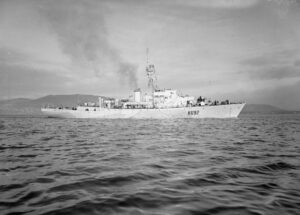 Oxford Castle was ordered to Harland and Wolff in Belfast on 23 Jan 1943, laid down on 21 Jun 1943, launched on 11 Dec 1943, completed on 10 Mar 1944. She was placed in reserve 1946, broken up 6 Sep 1960. No logs. If available they will be resumed here.
Oxford Castle was ordered to Harland and Wolff in Belfast on 23 Jan 1943, laid down on 21 Jun 1943, launched on 11 Dec 1943, completed on 10 Mar 1944. She was placed in reserve 1946, broken up 6 Sep 1960. No logs. If available they will be resumed here.
 Pevensey Castle (K449)
Pevensey Castle (K449)
Pevensey Castle was ordered to Harland and Wolff on 23 Jan 1943, laid down on 21 Jun 1943, launched on 11 Jan 1944 and completed on 10 Jun 1944. She was used on Air Sea Rescue Duties, South Atlantic in June 1945. placed in reserve in Feb 1946 at Portsmouth and until 1952. Refitted at Hull 12 August 1949, then reserve at West Hartlepool in 1954, dehumidified and preserved at Dowsons in 1954-1955 and earmarked for transfer to Air Ministry in 1957, made in 1960, Weather Monitor in 1959 after conversion, later Admiral Beaufort until 1982. Full war records on uboat.net and on weather ships records.
 Scarborough Castle (K536)
Scarborough Castle (K536)
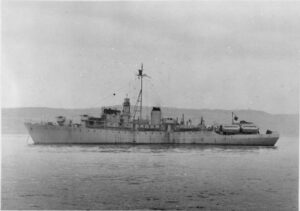 Scarborough Castle was ordered under the pennant K536 at Fleming & Ferguson on 23 Jan 1943 but construction was suspended in 1944, rresumed as rescue ship conversion, launched on 8 Sep 1944. She was completed in Jan 1945 as the convoy rescue ship SS Empire Peacemaker (Ministry of war Transports) managed by the Ellerman City Line: Eight convoys from early February to May 194, rescued three survivors from an aircraft overruning the flight deck of the MAC ship MV Empire MacAlpine.
Scarborough Castle was ordered under the pennant K536 at Fleming & Ferguson on 23 Jan 1943 but construction was suspended in 1944, rresumed as rescue ship conversion, launched on 8 Sep 1944. She was completed in Jan 1945 as the convoy rescue ship SS Empire Peacemaker (Ministry of war Transports) managed by the Ellerman City Line: Eight convoys from early February to May 194, rescued three survivors from an aircraft overruning the flight deck of the MAC ship MV Empire MacAlpine.
Full records.
Postwar she was versed to the Royal Army Service Corps as troop transport, and on October 1945 sailed from the Clyde to Arkhangelsk, to repatriate a RN Shore Party. In January 1946 she made three voyages between Southampton and St. Helier, in Jersey with returning service personnel.
In 1952 with Empire Shelter and Empire Lifeguard she shuttled Army personnel between Port Said and Famagusta in Cyprus as well as Libya and Malta.
She was laid up at Falmouth, Cornwall, in 1954 and sold for BU in July 1955 to a company in Antwerp.
 Tintagel Castle (K399)
Tintagel Castle (K399)
Tintagel Castle was ordered to Ailsa Shipbuilding Company on 23 Jan 1943, laid down on 29 April 1943, launched on 13 Dec 1943 and completed on 7 Apr 1944. Discarded Aug 1956, BU 1958.
 Amberley Castle (K386)
Amberley Castle (K386)
Amberley Castle was laid down at S P Austin & Son Ltd. on 2 Feb 1943, laid down on 31 May 1943, launched 25 Nov 1943, and completed on 24 Nov 1944. In reserve 1947. weather ship Weather Adviser in 1960.
 Berkeley Castle (K387)
Berkeley Castle (K387)
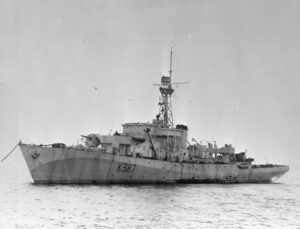 Berkeley Castle was ordered to Barclay Curle on 2 Feb 1943, laid down on 23 Apr 1943, completed on 19 Aug 1943 and commissioned on 18 Nov 1944. She joined the 15th Escort Group, first convoy in late January 1944. On 1 March, 40th Escort Group, Gibraltar convoy route. 23 May, B5 Escort Group, same. On 10 September 1944, the B5 Escort Group was renamed the 31st Escort Group and she returned to coastal waters until the end of the war. She became an air-sea rescue ship until mid 1946, then in reserve at Harwich, refitted at London in 1949, reserve. Night of 31 January/1 February while in dry dock at Sheerness, she was affected by the North Sea flood and the tidal surge overtopped the dock gates, and the flooding made her float off her blocks and capsize. She was refloated buty so damaged she was sold in 1955 BUT at Thos. W. Ward in Essex 29 February 1956.
Berkeley Castle was ordered to Barclay Curle on 2 Feb 1943, laid down on 23 Apr 1943, completed on 19 Aug 1943 and commissioned on 18 Nov 1944. She joined the 15th Escort Group, first convoy in late January 1944. On 1 March, 40th Escort Group, Gibraltar convoy route. 23 May, B5 Escort Group, same. On 10 September 1944, the B5 Escort Group was renamed the 31st Escort Group and she returned to coastal waters until the end of the war. She became an air-sea rescue ship until mid 1946, then in reserve at Harwich, refitted at London in 1949, reserve. Night of 31 January/1 February while in dry dock at Sheerness, she was affected by the North Sea flood and the tidal surge overtopped the dock gates, and the flooding made her float off her blocks and capsize. She was refloated buty so damaged she was sold in 1955 BUT at Thos. W. Ward in Essex 29 February 1956.
 Carisbrooke Castle (K379)
Carisbrooke Castle (K379)
Carisbrooke Castle K379 was ordered from Caledon Shipbuilding & Engineering on 2 Feb 1943, laid down on 12 Mar 1943, launched on 31 Jul 1943, completed on 17 Nov 1943. She served as a convoy escort until the end of the war in May 1945, covering Convoy SL 158, Combined convoy OS 78/KMS 52, Convoy SL 164. Full records. Postwar she was assigned to the Fishery Protection Flotilla in Devonport from April 1946, and then in reserve until May 1952, entering the 2nd Training Squadron at Portland until 1956. In 1953 she wa spresent at the Fleet Review for the Coronation of Queen Elizabeth II and was featured in the BBC short docufilm “A Brief Journey – sailor’s run ashore” in 1954. She was sold for BU at Faslane in June 1958.
 Dumbarton Castle (K388)
Dumbarton Castle (K388)
Dumbarton Castle (K388) was Caledon Shipbuilding & Engineering Company ordered on 2 Feb 1943, laid down on 6 May 1943, launched on 28 Sep 1943 and completed on 25 Feb 1944. She served as a convoy escort until the end of the war in May 1945. Combined convoy OS 78 / KMS 52, and Convoy SL 164. Full records. Placed in reserve April 1946, sold for scrap on 16 November 1960 at Gateshead from March 1961.
 Hurst Castle (K416)
Hurst Castle (K416)
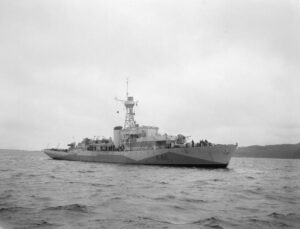 Hurst Castle (K416) was ordered to Caledon Shipbuilding & Engineering Company on 2 Feb 1943, laid down on 6 August 1943, launched on 23 Feb 1944 and completed on 9 Jun 1944. She was sunk by U-482 on 1 Sep 1944. She trained at the ASW base at Tobermory, Mull (HMS Western Isles), assigned later to Escort Group B3 on 3 July, escorted Convoy OS 85/KMS 59 to Gibraltar on 2 August and SL 167/MKS 58 from Gibraltar to UK later that month.
Hurst Castle (K416) was ordered to Caledon Shipbuilding & Engineering Company on 2 Feb 1943, laid down on 6 August 1943, launched on 23 Feb 1944 and completed on 9 Jun 1944. She was sunk by U-482 on 1 Sep 1944. She trained at the ASW base at Tobermory, Mull (HMS Western Isles), assigned later to Escort Group B3 on 3 July, escorted Convoy OS 85/KMS 59 to Gibraltar on 2 August and SL 167/MKS 58 from Gibraltar to UK later that month.
On 30 August Hurst Castle with Oxford Castle she departed Derry with Force 33 and detached to hunt down U-482, spotted by a RAF Consolidated B-24 Liberator patrol aircraft on 1 September. At 08:25, she was hit on the port side aft by a torpedo and sank in six minutes with 17 ratings. HMS Ambuscade rescued all 102 survivors. Read More
 Portchester Castle (K362)
Portchester Castle (K362)
Portchester Castle (K362) was ordered to Swan Hunter on 6 Feb 1943, laid down on 17 March 1943, launched on 21 Jun 1943 and completed on 8 Nov 1943. On 9 September 1944 with Helmsdale she sank U-484 in the North Atlantic north-west of Ireland. As part of the four vessels escorting the 30th Escort Group under Denys Rayner, she co-claimed U-1200 south of Ireland on 11 November 1944 with Pevensey Castle and Kenilworth Castle. She was paid off in 1947. In 1951 she played as HMS Saltash Castle in “Cruel Sea” (1953) and in the “The Man Who Never Was” (1955) and “Navy Lark” (1959). She ended scrapped at Troon in Scotland on 14 May 1958.
Read more
 Rushen Castle (K372)
Rushen Castle (K372)
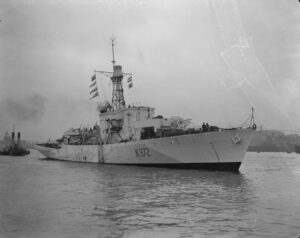
Rushen Castle (K372) was ordered to Swan Hunter on 6 Feb 1943, she was laid down on 8 April 1943 and launched on 16 Jul 1943, completed on 24 Feb 1944.
She was a convoy escort in WW2, placed in reseve, until transferred to the British Air Ministry on 26 September 1960 as a weather ship, recommissioned as “Weather Surveyor” on 21 December 1961. Sold on 15 July 1977, converted as salvage vessel. Scrapped at Hendrik-Ido-Ambacht, Netherlands in 1983.
R. C. Warwick, in “Really Not Required” detailed his wartime experience with her and HMS Saint Loman.
 Shrewsbury Castle (K374)
Shrewsbury Castle (K374)
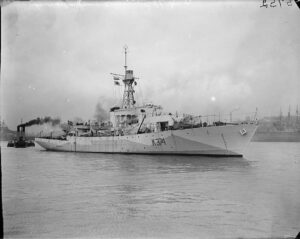 Shrewsbury Castle was ordered to Swan Hunter on 6 Feb 1943, laid down on 5 May 1943, launched on 16 Aug 1943 and completed on 24 April 1944 and she was transferred to Norway, renamed HNoMS Tunsberg Castle and Sunk by a mine on 12 Dec 1944.
Shrewsbury Castle was ordered to Swan Hunter on 6 Feb 1943, laid down on 5 May 1943, launched on 16 Aug 1943 and completed on 24 April 1944 and she was transferred to Norway, renamed HNoMS Tunsberg Castle and Sunk by a mine on 12 Dec 1944.
Read More/Src
Books
Links
https://www.silverhawkauthor.com/post/royal-canadian-navy-corvettes-castle-class-hmcs-arnprior-k494-to-hmcs-tillsonburg-k496
castlecorvette.co.uk
The full list and logs detailed on uboat.net/
en.wikipedia.org/ Castle-class_corvette
navweaps.com
Videos
Model Kits
on whiteensignmodels.com HMS PORTCHESTER
on 1999.co.jp/
on the-blueprints.com/
http://www.naval-history.net/xGM-Chrono-20Cor-Castle-LancasterCastle.htm

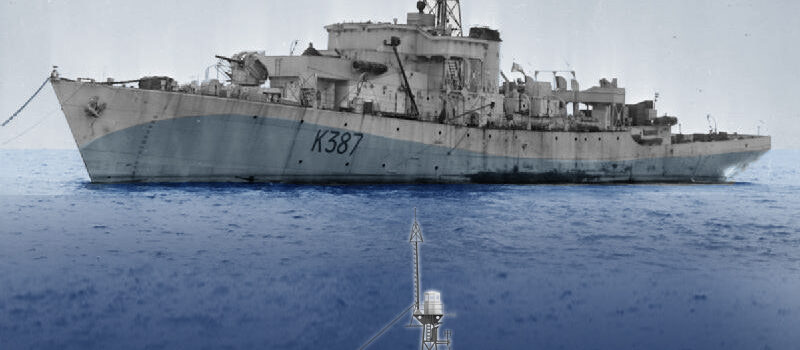


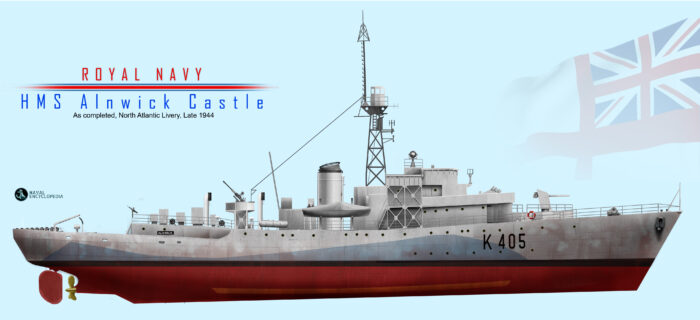
 Latest Facebook Entry -
Latest Facebook Entry -  X(Tweeter) Naval Encyclopedia's deck archive
X(Tweeter) Naval Encyclopedia's deck archive Instagram (@navalencyc)
Instagram (@navalencyc)





 French Navy
French Navy Royal Navy
Royal Navy Russian Navy
Russian Navy Armada Espanola
Armada Espanola Austrian Navy
Austrian Navy K.u.K. Kriegsmarine
K.u.K. Kriegsmarine Dansk Marine
Dansk Marine Nautiko Hellenon
Nautiko Hellenon Koninklije Marine 1870
Koninklije Marine 1870 Marinha do Brasil
Marinha do Brasil Osmanlı Donanması
Osmanlı Donanması Marina Do Peru
Marina Do Peru Marinha do Portugal
Marinha do Portugal Regia Marina 1870
Regia Marina 1870 Nihhon Kaigun 1870
Nihhon Kaigun 1870 Preußische Marine 1870
Preußische Marine 1870 Russkiy Flot 1870
Russkiy Flot 1870 Svenska marinen
Svenska marinen Søværnet
Søværnet Union Navy
Union Navy Confederate Navy
Confederate Navy Armada de Argentina
Armada de Argentina Imperial Chinese Navy
Imperial Chinese Navy Marinha do Portugal
Marinha do Portugal Mexico
Mexico Kaiserliche Marine
Kaiserliche Marine 1898 US Navy
1898 US Navy Sovietskiy Flot
Sovietskiy Flot Royal Canadian Navy
Royal Canadian Navy Royal Australian Navy
Royal Australian Navy RNZN Fleet
RNZN Fleet Chinese Navy 1937
Chinese Navy 1937 Kriegsmarine
Kriegsmarine Chilean Navy
Chilean Navy Danish Navy
Danish Navy Finnish Navy
Finnish Navy Hellenic Navy
Hellenic Navy Polish Navy
Polish Navy Romanian Navy
Romanian Navy Turkish Navy
Turkish Navy Royal Yugoslav Navy
Royal Yugoslav Navy Royal Thai Navy
Royal Thai Navy Minor Navies
Minor Navies Albania
Albania Austria
Austria Belgium
Belgium Columbia
Columbia Costa Rica
Costa Rica Cuba
Cuba Czechoslovakia
Czechoslovakia Dominican Republic
Dominican Republic Haiti
Haiti Hungary
Hungary Honduras
Honduras Estonia
Estonia Iceland
Iceland Eire
Eire Equador
Equador Iran
Iran Iraq
Iraq Latvia
Latvia Liberia
Liberia Lithuania
Lithuania Mandchukuo
Mandchukuo Morocco
Morocco Nicaragua
Nicaragua Persia
Persia San Salvador
San Salvador Sarawak
Sarawak Uruguay
Uruguay Venezuela
Venezuela Zanzibar
Zanzibar Warsaw Pact Navies
Warsaw Pact Navies Bulgaria
Bulgaria Hungary
Hungary

 Bundesmarine
Bundesmarine Dutch Navy
Dutch Navy Hellenic Navy
Hellenic Navy Marina Militare
Marina Militare Yugoslav Navy
Yugoslav Navy Chinese Navy
Chinese Navy Indian Navy
Indian Navy Indonesian Navy
Indonesian Navy JMSDF
JMSDF North Korean Navy
North Korean Navy Pakistani Navy
Pakistani Navy Philippines Navy
Philippines Navy ROKN
ROKN Rep. of Singapore Navy
Rep. of Singapore Navy Taiwanese Navy
Taiwanese Navy IDF Navy
IDF Navy Saudi Navy
Saudi Navy Royal New Zealand Navy
Royal New Zealand Navy Egyptian Navy
Egyptian Navy South African Navy
South African Navy






























 Ukrainian Navy
Ukrainian Navy dbodesign
dbodesign